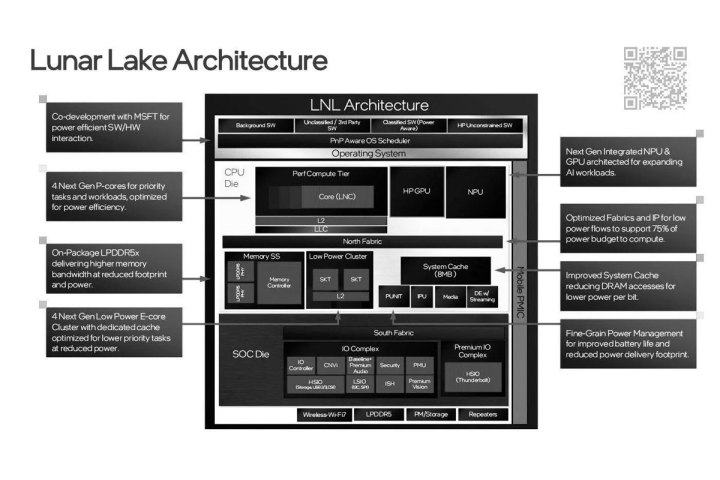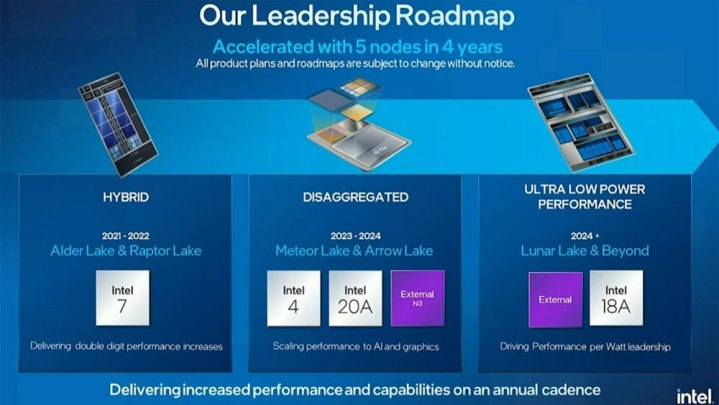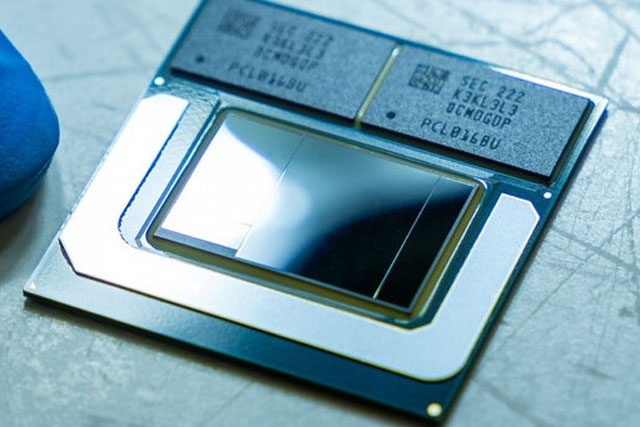
You and I might be hotly anticipating what Intel’s next-generation Arrow Lake processors will do later this year, but that doesn’t mean we can’t get excited about what comes after or even alongside it, right? Intel’s Lunar Lake is its next, next-generation design, tentatively outlined for a launch maybe before the end of the year. Maybe alongside Arrow Lake on desktop, with Lunar Lake focused on mobile instead.
Curious to see what Intel’s been cooking up in the labs? We are, too, and as we get closer to Lunar Lake’s debut, we’re starting to learn some intriguing details.
Lunar Lake specs
We don’t have hard specifications for Lunar Lake just yet, but we do have a few details from Intel and some purported leaks, which paint an interesting picture of what Lunar Lake will be capable of.
It’s a mobile-first architectural design with a wattage target of around 15W, suggesting Lunar Lake will be used for Intel’s traditional U-series processors. With a focus on performance per watt, it seems likely that we’ll see lower clock speeds with this generation and a focus on Intel’s efficiency cores. Indeed, one eight-core configuration leaked earlier this year (via GameRant), reportedly included four Skymont efficiency cores (the same E-core architecture planned for Arrow Lake), and four Lion Cove performance cores.

Lunar Lake will allegedly utilize a next-generation graphics architecture, too, known as Battlemage Xe2-LPG. That’s the next-generation design beyond the alleged Battlemage Xe+ design that Arrow Lake is slated to use for its onboard graphics.
Other rumors suggest that Intel is dropping hyperthreading (its version of simultaneous multi-threading) from Lunar Lake, as it is reportedly planning with Arrow Lake. This feature has been a cornerstone of Intel CPU multi-threaded performance for generations, so Intel must have a good reason for dropping it to the wayside.
Intel may also launch a low 8W power version of its Lunar Lake processors, targeting fanless laptop designs to compete with Apple’s MacBook Air more readily.
As for features, Lunar Lake will supposedly support PCI-Express 5, Thunderbolt 4 and USB4, HDMI 2.1, DisplayPort 2.1, Wi-Fi 7, Bluetooth 5.4, and Gigabit Ethernet
Lunar Lake availability
Lunar Lake is reportedly planned for an end-of-2024 release alongside Arrow Lake on desktop. That seems like a pretty quick turnaround, considering we haven’t heard much about it yet, but Intel has claimed to show working silicon at recent tradeshows, so it’s not impossible. Purportedly, the plan is for Lunar Lake to be the main focus of Intel’s entry-level and energy-efficient laptop designs, especially casual gaming efforts.

Arrow Lake will then be used for higher-end mobile designs and desktops. If Lunar Lake does debut alongside Arrow Lake, though, expect availability to be limited to start with, leading to mass production in early 2025.
Lunar Lake performance
Despite its target of lower-power laptops, Intel’s Lunar Lake is allegedly a seriously powerful design. The first ground-up architectural overhaul in a few generations, Lunar Lake will continue to leverage Intel’s Foveros technology to have larger performance and smaller efficiency cores. Dropping hyperthreading reportedly won’t slow it down, though, as early reports suggest that Lunar Lake could offer performance close to 1.5 times that of Meteor Lake processors at a very comparable power draw.
This cited performance metric is only in Cinebench multi-threaded, which isn’t a perfect snapshot of a processor’s performance, but it’s an intriguing indication of what it’s capable of, nonetheless.
Rumors suggest Lunar Lake will manage a 50% performance boost over existing Meteor Lake processors. This would be an incredible inter-generational leap and a claim that we will only view through our skeptic’s glasses for now. There are also some rumors of Lunar Lake’s integrated GPU performance doubling that of Meteor Lake at a higher TDP. Lunar Lake could be amazing for low-cost, low-power gaming laptops if that proves true.
Intel will be able to utilize a new process node to eke out some extra performance, or efficiency, depending on what it’s targeting. It won’t use its internal process nodes, though, and will instead be based on TSMCs 3nm 3NB process.
Intel has also said Lunar Lake’s neural processing unit (NPU) will be up to three times faster than Meteor Lake’s, which could help it accelerate future AI tasks.
It’s all up in the air
For a CPU design that many claim will launch before the end of 2024, the details for Lunar Lake are very thin on the ground. That would typically suggest a launch is further away, and perhaps we won’t see wide availability until 2025. However, it is encouraging to hear that Intel is working hard to address the disparity in energy efficiency between AMD and Intel CPUs. The latest desktop versions, in particular, highlight an enormous disparity, where comparably performing Intel CPUs often use more than twice the power of their AMD counterparts.
For now, Lunar Lake is an intriguing what-if that’s coming at some point in the future. It’s got potential, but we’ll need to hear more before we get truly excited about what it’s bringing to the table.
Editors’ Recommendations
Services Marketplace – Listings, Bookings & Reviews
